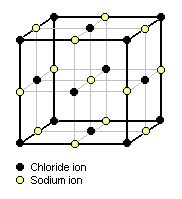User:Milton Beychok/Sandbox: Difference between revisions
imported>Milton Beychok No edit summary |
imported>Milton Beychok No edit summary |
||
| Line 1: | Line 1: | ||
[[Image:NaCl Crystal Structure.png|182px|thumb|right|Cubic lattice structure of crystalline Sodium chloride]] | [[Image:NaCl Crystal Structure.png|182px|thumb|right|Cubic lattice structure of crystalline Sodium chloride]] | ||
==Measurement of density== | |||
For a homogeneous solid object, the mass divided by the volume gives the density. The mass is normally measured with an appropriate [[Weighing scale|weighing scale or balance]] and the volume may be measured directly (from the geometry of the object) or by the displacement of a liquid. | |||
A very simple and commonly used instrument for directly measuring the density of a liquid is the [[hydrometer]]. A less common device for measuring fluid density is a pycnometer and a similar device for measuring the absolute density of a solid is a gas pycnometer. | |||
Another instrument used to determine the density of a liquid or a gas is the digital density meter, based on the [[oscillating U-tube]] principle. | |||
==Density of irregular shaped solid object heavier than water== | |||
One of the many statements attributed to the [[Archimedes principle]] is that an object immersed in a fluid apparently loses weight by an amount equal to the weight of the fluid displaced.<ref>[http://www.csudh.edu/oliver/satcoll/archmede.htm California State University Dominguez Hills]</ref><ref>{{cite book|author=Murat Bengisu|title=Engineering Ceramics|edition=First Edition|publisher=Springer|pages=pages 363-366|id=ISBN 3-540-67687-2}}</ref><ref>[http://www.astm.org/Standards/C373.htm ASTM C373-88] Standard Test Method for Water Absorption, Bulk Density, Apparent Porosity and Apparent Specific Gravity of Fired Whiteware</ref> That principle makes it possible to determine of the density of a solid object that is denser than water and is so irregular in shape that its volume cannot be measured directly. | |||
First, the object's dry weight in air, <math>W_d</math>, is measured. Next, the weight of the object while submerged in water, <math>W_s</math>, is measured. Then the submerged object is removed from the water, the excess surface water is removed and the wet weight in air, <math>W_w</math>, is measured.<ref>{{cite book|author=American Society of Composites|title=American Society of Composites, Ninth International Conference Proceedings|edition=|publisher=CRC Press|year=1994|pages=page 539|id=1-56676-220-0}}</ref> The density of the object, <math>\rho_o</math>, is then obtained from: | |||
:<math>\rho_o = \frac{m}{V} = \frac{W_d}{(W_w - W_s)/\rho_{water}} = \frac{W_d \cdot \rho_{water}}{W_w - W_s}</math> | |||
and the volumetric [[porosity]] fraction, <math>p</math> can be obtained from: | |||
:<math>p = \frac{W_w - W_d}{W_w - W_s}</math> | |||
==Density of solid objects by x-ray diffraction crytallography]] | |||
For some [[crystal|crystalline]] materials, density can be calculated based on [[Crystallography|crystallographic information]] and [[molecular mass]]: | |||
:<math>\mbox{density} = \frac{M \cdot N} {L \cdot a \cdot b \cdot c} </math> | |||
where: | |||
:'''''M''''' is [[molecular mass]] | |||
:'''''N''''' is the number of atoms in a [[unit cell]] | |||
:'''''L''''' is [[Loschmidt]] or [[Avogadro's constant]] | |||
:'''''a''''', '''''b''''', '''''c''''' are the [[lattice parameters]] | |||
Revision as of 17:17, 17 June 2008
Measurement of density
For a homogeneous solid object, the mass divided by the volume gives the density. The mass is normally measured with an appropriate weighing scale or balance and the volume may be measured directly (from the geometry of the object) or by the displacement of a liquid.
A very simple and commonly used instrument for directly measuring the density of a liquid is the hydrometer. A less common device for measuring fluid density is a pycnometer and a similar device for measuring the absolute density of a solid is a gas pycnometer.
Another instrument used to determine the density of a liquid or a gas is the digital density meter, based on the oscillating U-tube principle.
Density of irregular shaped solid object heavier than water
One of the many statements attributed to the Archimedes principle is that an object immersed in a fluid apparently loses weight by an amount equal to the weight of the fluid displaced.[1][2][3] That principle makes it possible to determine of the density of a solid object that is denser than water and is so irregular in shape that its volume cannot be measured directly.
First, the object's dry weight in air, , is measured. Next, the weight of the object while submerged in water, , is measured. Then the submerged object is removed from the water, the excess surface water is removed and the wet weight in air, , is measured.[4] The density of the object, , is then obtained from:
and the volumetric porosity fraction, can be obtained from:
==Density of solid objects by x-ray diffraction crytallography]]
For some crystalline materials, density can be calculated based on crystallographic information and molecular mass:
where:
- M is molecular mass
- N is the number of atoms in a unit cell
- L is Loschmidt or Avogadro's constant
- a, b, c are the lattice parameters
- ↑ California State University Dominguez Hills
- ↑ Murat Bengisu. Engineering Ceramics, First Edition. Springer, pages 363-366. ISBN 3-540-67687-2.
- ↑ ASTM C373-88 Standard Test Method for Water Absorption, Bulk Density, Apparent Porosity and Apparent Specific Gravity of Fired Whiteware
- ↑ American Society of Composites (1994). American Society of Composites, Ninth International Conference Proceedings. CRC Press, page 539. 1-56676-220-0.








